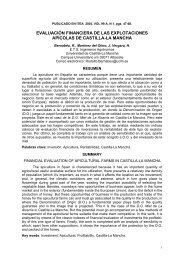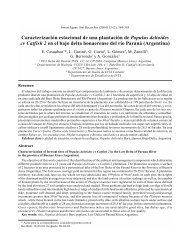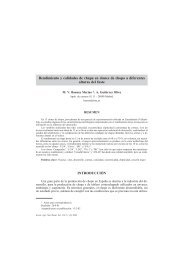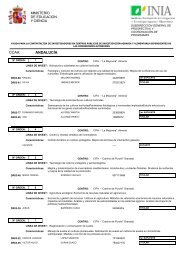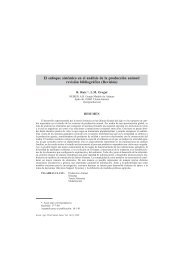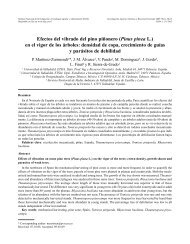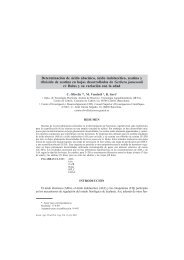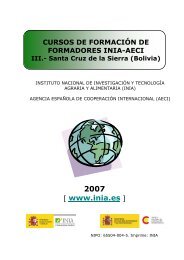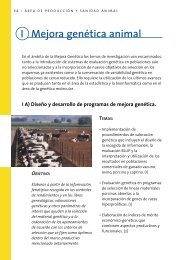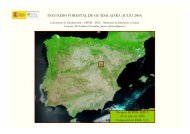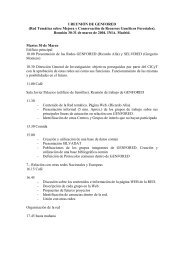Status of medicinal and aromatic plants in - Inia
Status of medicinal and aromatic plants in - Inia
Status of medicinal and aromatic plants in - Inia
Create successful ePaper yourself
Turn your PDF publications into a flip-book with our unique Google optimized e-Paper software.
132<br />
WORKING GROUP ON MEDICINAL AND AROMATIC PLANTS: FIRST MEETING<br />
The majority <strong>of</strong> <strong>medic<strong>in</strong>al</strong> <strong>plants</strong> grow spontaneously <strong>in</strong> meadows, sometimes form<strong>in</strong>g<br />
very abundant groups. Intensive utilization <strong>of</strong> <strong>medic<strong>in</strong>al</strong> <strong>plants</strong> has led to a dim<strong>in</strong>ution <strong>of</strong><br />
many plant populations <strong>and</strong> even disappearance <strong>of</strong> some species.<br />
More than 200 MAPs grow<strong>in</strong>g <strong>in</strong> the meadows <strong>and</strong> pastures <strong>of</strong> Serbia were classified <strong>in</strong>to<br />
136 genera <strong>of</strong> 49 families with a predom<strong>in</strong>ance <strong>of</strong> hemicryptophytes (65.91%) <strong>and</strong> geophytes<br />
(10.23%) (Dajić et al. 2000).<br />
The participation <strong>of</strong> MAPs <strong>in</strong> the entire floristic spectrum <strong>of</strong> the best developed<br />
meadow/pasture communities <strong>of</strong> hilly-mounta<strong>in</strong>ous regions <strong>in</strong> Serbia ranges from 21.7% to<br />
less than 50% (Dajić et al. 2000) (Fig. 1).<br />
50<br />
40<br />
30<br />
%<br />
20<br />
10<br />
0<br />
1 2 3 4 5 6 7 8 9 10 11 12 13 14 15<br />
Fig 1. Participation <strong>of</strong> <strong>medic<strong>in</strong>al</strong> flora <strong>in</strong> different hilly meadow communities (%).<br />
1. Agrostietum vulgaris 9. Chrysopogonetum pannonicum<br />
2. Asperuleto-Agrostietum vulgaris 10. Danthonietum calyc<strong>in</strong>ae<br />
3. Agrostio-Festucetum valesiaceae 11. Cynosuretum cristati<br />
4. Festucetum valesiaceae 12. Inulo salic<strong>in</strong>ae-Calamagrostietum epigeio<br />
5. Rh<strong>in</strong>antho-Festucetum valesiaceae 13. Artemisio-Salvietum <strong>of</strong>fic<strong>in</strong>alis<br />
6. Festuco-Chrysopogonetum grylli 14. Brometum erecti<br />
7. Thymo-Chrysopogonetum grylli 15. Koelerietum montanae<br />
8. Chrysopogonetum grylli<br />
Regard<strong>in</strong>g the potential <strong>of</strong> MAP utilization <strong>in</strong> Yugoslavia, it should be stressed that except<br />
hilly-mounta<strong>in</strong>ous region <strong>of</strong> Yugoslavia, which are rich <strong>in</strong> various types <strong>of</strong> forests <strong>and</strong><br />
meadows, very important MAP resources are found <strong>in</strong> the northern lowl<strong>and</strong> part <strong>of</strong> Serbia<br />
(Vojvod<strong>in</strong>a) <strong>and</strong> the coastal region <strong>of</strong> Montenegro.<br />
The area <strong>of</strong> Vojvod<strong>in</strong>a is very suitable for MAP production because <strong>of</strong> its favourable<br />
environmental conditions (climate <strong>and</strong> soil). The commonest cultivated MAPs <strong>in</strong> this region<br />
are: chamomile, dill, m<strong>in</strong>t, sweet marjoram, parsley, tarragon, marshmallow, celery, valerian,<br />
lemon balm, poppy, sage, black mustard, cori<strong>and</strong>er, thyme, etc.; a significant number <strong>of</strong> wild<br />
MAPs has been also registered (Kišgeci <strong>and</strong> Sekulović 2000).<br />
In Montenegro, collect<strong>in</strong>g <strong>and</strong> process<strong>in</strong>g <strong>of</strong> MAPs is a long tradition. Among wild<br />
MAPs, many <strong>of</strong> which belong to the Mediterranean <strong>and</strong> sub-Mediterranean floristic element,<br />
the follow<strong>in</strong>g could be stressed: sage (Salvia <strong>of</strong>fic<strong>in</strong>alis), lavender (Lav<strong>and</strong>ula vera), thyme<br />
(Thymus sp.), abs<strong>in</strong>the (Artemisia abs<strong>in</strong>thium), xeranthemum (Helichrysum arenarium), ole<strong>and</strong>er<br />
(Nerium ole<strong>and</strong>er), rosemary (Rosmar<strong>in</strong>us <strong>of</strong>fic<strong>in</strong>alis), olive (Olea europea), jasm<strong>in</strong>e (Jasm<strong>in</strong>um<br />
<strong>of</strong>fic<strong>in</strong>alis), seaside onion (Scilla maritima), pyrethrum (Chrysanthemum c<strong>in</strong>erariaefolium) <strong>and</strong><br />
many others (especially members <strong>of</strong> the Labiatae).




